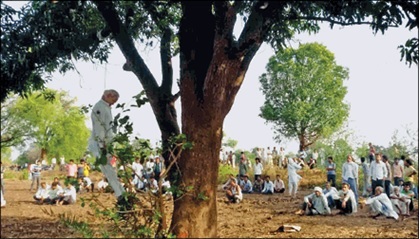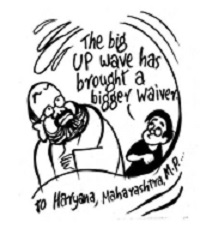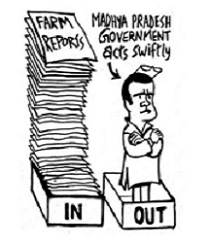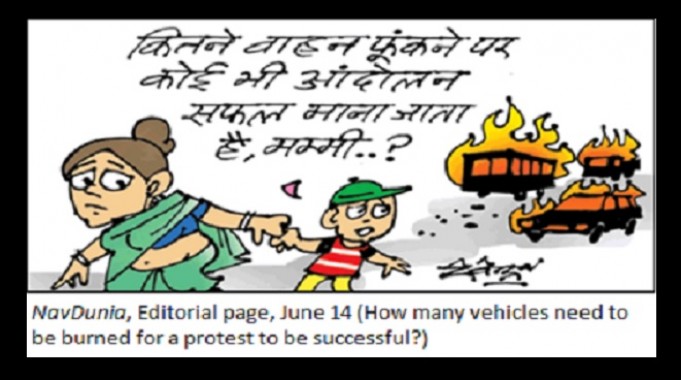Re-examining the Mandsaur agitation
Farmers’ associations in Madhya Pradesh announced a “strike from June 1 for a period of 10 days, to press for a loan waiver and remunerative prices for their produce.” The protests turned violent and six people were killed in police action against protestors on June 6 in Mandsaur (Madhya Pradesh). Ironically, a day after they were killed during protests, the Express and Nai Dunia published full page government advertisements listing MP’s achievements in the agriculture sector.
This article analyses the coverage of the farmers’ agitation in Madhya Pradesh in the Delhi edition of The Indian Express and the Bhopal edition of Nai Dunia (the Bhopal edition is published under the name of Nav Dunia) between June 7 and June 14.
Similarities and differences
- While the Express highlighted the involvement of unemployed youth in the violence, Nav Dunia focused on the negligence of the administration in controlling lawlessness.
- Nav Dunia provided greater geographical coverage than the Express.
- Both newspapers reported suicides of farmers who were unable to meet the burden of loans, and maintained that while waiving loans had calmed the farmers’ anger it had also failed to provide a long term solution to their problems.
- Both noted that the fall in prices this year owing to a bumper harvest, among other things, was the main cause of farmer unrest. But unlike Nav Dunia, the Express highlighted demonetization as a major factor behind the fall in prices.
- In analysis, as well as suggestions, the Express gave space to national and global factors while Nav Dunia’s coverage was more focused on the state and local factors.
Factors in the protests
Express mainly focused on Mandsaur, Bhopal and Dewas, while Nav Dunia covered incidents of violence in several other locations in addition to these three places. And both dailies reported that the agitation turned violent as the government had not paid adequate attention initially. It was only when the situation went out hand, that the Bharatiya Kisan Sangh (BKS) was chosen for negotiation and a settlement announced hurriedly (Nav Dunia, June 7; Express, June 11).
Both reported that social media played an important role in the spread of the protests (NavDunia, June 9 and Express, June 14). They highlighted the role of Shiv Kumar Sharma of the Rashtriya Kisan Mazdoor Sangh (RKMS), while noting the involvement of the BKS and the Bharatiya Kisan Union (BKU) (NavDunia, June 7 and Express, June 8). None of the unions took responsibility for the violence. NavDunia published an opinion piece written by Shiv Kumar Sharma (June 7), while the Express quoted him in its news reports.
Both newspapers highlighted that farmers involved in the movement seemed “to be concentrated in the relatively more prosperous agriculture belts,” unlike drought-prone Marathwada, Vidarbha or Bundelkhand (Express, June 9; NavDunia, June 12). The Express noted the involvement of (seasonally) unemployed youth in the Mandsaur protests (“After the winter crop is harvested and before sowing for kharif crop begins, youngsters of farming families have nothing on their hands,” June 14) and pointed out that the six dead farmers had been landless and jobless (June 9).
The Express contacted the BJP MLA from Mandsaur, Yashpal Sisodiya, who observed that “the violence was a fallout of a combination of factors - falling prices, demonetisation, difficulty in getting loans from cooperatives, anger against local policemen, involvement of anti-social elements and even the liquor mafia and infiltration of the movement by criminals.”
He added: “The police took on the liquor mafia after a local journalist was shot dead near Pipliya Mandi last month. Police had rounded up nearly 50 people, angering them” (Express, June 11). Another Express story from the field noted “the tussle between traders [vendors in nearby towns] and protestors [who wanted to shut the shops] as the genesis of the violence” (Express, June 14). Surjit S Bhalla claimed that the agitation was politically motivated, hinting at a struggle within the Sangh Parivar (Express, June 10).
NavDunia highlighted the negligence of the local administration in controlling the lumpen elements (June 7) and communicating with protestors (June 8). It compared the 1998 Multai agitation with Mandsaur and noted that the governments of two different parties in different times made the same mistakes in handling the farmers’ agitation (June 10).
A NavDunia cartoon questioned the farmers’ union for resorting to violence (June 14, Image 2). Sanjay Gupta, CEO of the Dainik Jagran group, highlighted police inefficiency in controlling lumpen elements and a political conspiracy against Shivraj Singh Chauhan (NavDunia, June 12).
Pros and cons of loan waivers
NavDunia reported the MP government’s decisions to ease the situation, including the purchase of onion at revised prices, the extension of dates for the purchase of green gram (moong) and red gram (arhar) (June 7), changes in payment rules to handle the cash crunch (June 7 and June 14), and waiving of interest on loans under an agriculture loan settlement scheme for defaulters (June 8).

Nav Dunia, page 1, June 14 (Farmer Makhanlal took this step in depression because he had to sell more than two-thirds of his land to repay his loan)
During the period of interest, Maharashtra waived the loans of small farmers and Madhya Pradesh made announcements regarding minimum support prices, land acquisition, etc. and Madhya Pradesh’s agriculture minister explicitly opposed the demand for a loan waiver as the MP government provides agricultural loans at a 10 percent rebate (NavDunia, June 11).
While both newspapers reported the suicides of farmers who were unable to meet the burden of loans, they suggested that waiving loans was the easiest way to assuage the anger of farmers, but not a solution to the larger problems facing them (Image 3). Editorials in NavDunia (June 8 and June 13) and Express (June 13, also cartoons) blamed the newly elected UP government for growing demands for loan waivers. However, NavDunia called the demand of Tamil Nadu farmers who wanted a loan waiver after a drought, genuine.
 |
 |
|
Express, page 1, June 8 |
Express, page 1, June 9 |
Both newspapers buttressed their stand with the help of expert opinion. The Express quoted Niti Aayog member Professor Ramesh Chand on loan waivers: “Farmers in India are being spoilt by politicians through populist measures such as loan waivers . . . they want free water, free fertilizer, they want loan waivers, and they want governments to pay 50 per cent of the price of the cost of production. No country can meet these kinds of things.”
Another Express report quoted Devidas Tuljapurkar, Joint Secretary of the All India Bank Employees Association: “While in the immediate short term, the NPAs of banks will be closed and fresh finance to borrowers will be possible, in the long term, the recovery climate will be vitiated and the entire banking system will be in a crisis” (June 11).
Opinion writers were also broadly opposed to loan waivers. Arti Gupta argued that politically motivated loan waivers benefitted only a small segment of farmers and did not help the agriculture sector in the long run (NavDunia, June 13).
Shaji Vikraman noted that while loan waivers might be politically motivated, they were needed as farmers have been unable to repay because of crop failures or bumper harvests. But he admitted that they “encourage a culture of indiscipline among borrowers” (Express, June 14).
Falling prices and farmer distress
NavDunia published an opinion piece by Shiv Kumar Sharma (RKMS), which pointed out that prices of agricultural products have not risen relative to all other commodities and the farmer does not even get the cost of his produce (June 7).

NavDunia, page 1, June 14
Price decline and cash crunch were reported by both newspapers as a major reason of unrest among farmers. NavDunia’s editorial blamed the state government for not making arrangements to buy crops on time and not offering a reasonable price (June 9). An Express editorial blamed demonetisation for the cash crunch and decline in prices: “After successive droughts, this was a bumper crop year from which they [farmers] should have benefited. Unfortunately, they were done in by low prices, for which demonetisation, it is now clear, was significantly to blame.” (June 9, also see June 11, June 13).
On the impact of demonetisation, the Express reported the statement of the BJP MLA from Mandsaur who said “The situation was bad due to low prices, and got worse after demonetisation” (June 11). Harish Damodaran blamed demonetisation for the price fall and for affecting trading in the agriculture sector: “Much of the produce trading in India is cash-based and financed through a chain of [intermediaries] . . . While difficult to establish, anecdotal reports suggest that this traditional agro-commercial capital was dealt a body blow by demonetisation. The collateral damage from it has been a haemorrhaging of liquidity from the markets” (Express, June 12).
It is interesting that more than six months after demonestisation was introduced, we are still relying on anecdotes.
It was pointed out that lower prices benefit consumers (Sandeep Singh, Express, June 14). NavDunia reported the decline in the inflation rates, but did not link it with the decline in the prices of crops (June 13). NavDunia argued that if the MP government adopts the system followed by Amul in purchasing the milk (as announced by the CM for dairy farmers), it will ultimately result in higher prices which will affect the consumer in the end (June 14). There was no discussion on how to balance the competing interests of farmers and (urban) consumers.
Apart from the price fall and cash crunch, the role of traders was also reported by both newspapers. The Express reported that farmers “directed their anger at traders, alleging that they bought produce at low rates only to sell to the government at MSP” and “while government agencies throw the rule book at us and refuse to buy, citing lack of quality, traders face no such problem” (June 11, also NavDunia June 7). Another Express report noted the upper hand enjoyed by traders since demonetisation (June 14).
NavDunia also reported the disagreement of traders with new trading rules announced by the CM that criminalise the purchase of crops irrespective of quality below the minimum support price (June 13) and which mandate 50 percent payment in cash and the rest through bank transfer (June 11, June 14).
While the cash crunch and the possible political aspects of the agitation were noted by both newspapers, neither discussed the role of politicians who have tremendous influence in cooperative banks which are supposed to ensure the availability of cash to farmers. However, NavDunia highlighted the operational lapses at district cooperative societies and banks (June 7, June 9 and June 13).
The way ahead
J.S. Kaushal, former director agriculture (Madhya Pradesh) suggested the adoption of earlier practices like preserving seeds, planting different crops and using organic fertiliser to reduce the cost of inputs. Sanjay Gupta, CEO of the Dainik Jagran group, suggested the development of jobs in non-agriculture sectors to remove the dependence on agriculture, providing input subsidies to reduce costs and better crop insurance to minimise losses due to calamities (NavDunia, June 12). However, in the case of bumper crops and price deflation, crop insurance does not help farmers.
The MP Agriculture Minister pointed out the lack of information about market demands of different crops (NavDunia, June 14) but did not suggest how to plug this gap.
NavDunia recalled the statement of Atal Bihari Vajpayee in which he advocated the self-reliance of farmers by ensuring the availability of water, fertiliser, and electricity rather than providing exemptions or subsidies (June 10).
An Express editorial recommended investing in improving infrastructure instead of loan waivers: “We can be sure that Rs 2-3 lakh crore spent on rural roads, godowns, power supply, irrigation, agricultural research and crop insurance would generate farm incomes, which is the only sustainable antidote to indebtedness” (June 13).
Another Express editorial (June 9) called for “institutional finance, modern agro-processing and organised retail, both domestic and foreign,” “the removal of all restrictions on stockholding, domestic movement and exports,” and “higher import duties, especially on pulses and edible oils, as a temporary measure.”
While everyone is suggesting new measures, it is not clear how the government can ensure that farmers are informed about all the schemes and ensure that they are implemented (NavDunia, June 8, June 12, and June 14). Pushpendra Dubey pointed out an important issue - the fact that the politicisation of the Panchayati Raj system has corrupted local governance at the grassroots. Dubey called for village reconstruction with the participation of people (NavDunia, June 7).
Other important issues ignored in the debate that followed the farmers’ agitation include the need to make agriculture climate change adaptable, regulate genetically modified crops, revive agricultural research in the public sector, regulate the potential corporatisation of agriculture, and promote adult and continuing education in villages.
Unfortunately, the entire debate happened after the death of six people. The media mostly remembers agriculture and villages only during elections and crises. There is a need for a sustained engagement. Had this crisis not happened, on June 7, the day after six people were killed, in both the Express and NavDunia, we would have only found full page advertisements listing the government’s achievements in agriculture.
Ankita Pandey is an independent researcher based in Bengaluru







